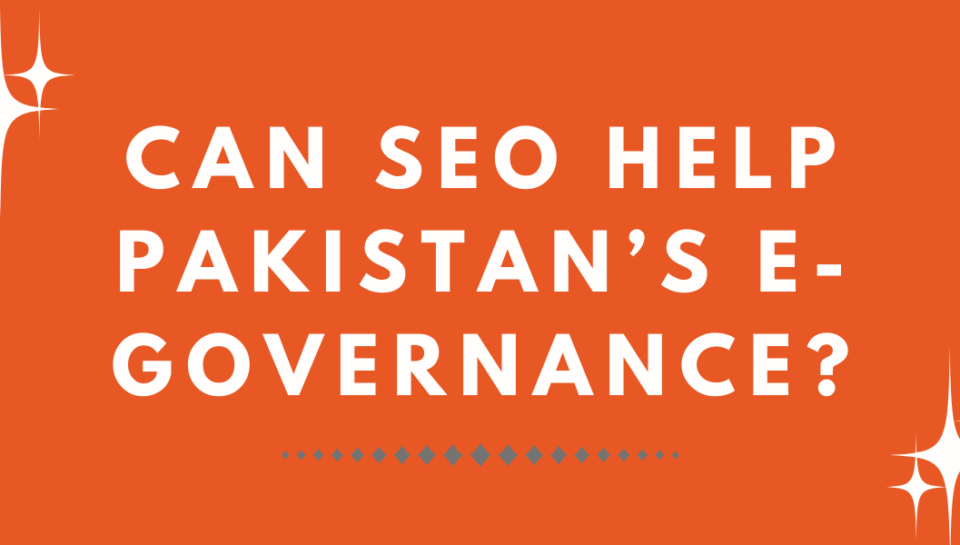
Pakistan has invested heavily in digital governance over the last decade: citizen portals, online tax filing, e‑challans, and provincial service platforms now handle millions of interactions. Yet many citizens still struggle to find the right service, understand the steps, or trust that an online answer is official and up to date. That is a findability problem—and Search Engine Optimization (SEO) is built to solve it. Done right, SEO can help Pakistan’s e‑governance deliver faster, clearer, and more inclusive public services.
Why SEO Matters for E‑Governance in Pakistan
SEO is not only for e‑commerce or news sites. For public services, it directly supports policy outcomes: awareness, adoption, compliance, and satisfaction. Consider the realities of Pakistan’s digital landscape:
- Mobile-first usage: Most Pakistanis access the web through smartphones and affordable data packages. Government pages must be fast, mobile-friendly, and usable on low-end devices.
- Multilingual search behavior: Citizens search in Urdu, Roman Urdu, and regional languages (Punjabi, Sindhi, Pashto, Balochi), often mixing English terms (e.g., “CNIC renewal online Urdu”).
- Information overload and duplication: Multiple government domains, PDFs, outdated notices, and news posts can bury the correct service page.
- Trust and authenticity: Official answers should rank above hearsay and outdated blogs to reduce misinformation and improve confidence in digital government.
- Cost to serve: When search results surface the exact step-by-step pages, call center volumes drop, queues shorten, and service delivery costs fall.
Search is the first step in the citizen journey. Optimizing for real search intent helps citizens get to the right government page in one click—and complete their task without confusion.
What SEO Looks Like for Government Portals
1) Technical Foundations: Crawlable, Fast, and Secure
- Crawlability and indexation: Clean robots.txt and XML sitemaps per subdomain and ministry; avoid blocking key service URLs; use canonical tags to prevent duplicate indexing.
- Core Web Vitals: Optimize Largest Contentful Paint (speed), Interaction to Next Paint (interactivity), and Cumulative Layout Shift (stability). Compress images, lazy-load media, and minimize JavaScript.
- Mobile-first design: Responsive layouts, tap targets sized for small screens, minimal pop‑ups, and accessible forms that work on 3G/4G.
- HTTPS and trust signals: Sitewide HTTPS, HSTS, and visible “official government” indicators (e.g., .gov.pk domains, verifiable contact details) increase citizen confidence.
- Resilience: Use caching/CDNs for national events (admissions, tax deadlines) to prevent outages and maintain consistent rankings.
2) Information Architecture and Content Strategy
- Task-first structure: Organize navigation around actions citizens take (Apply, Renew, Verify, Pay) rather than internal department names.
- Plain language: Replace legalese with clear, simple Urdu and English; use checklists and step-by-step guides for each service.
- How-to models: Build “How to renew CNIC” or “How to file FBR returns via Iris” pages with requirements, fees, timelines, and FAQs on one page.
- Content freshness: Timestamp pages and maintain an update log so citizens can trust the latest requirements.
- Reduce PDF dependency: Provide web-native content with an optional PDF. Search engines index web pages more comprehensively than PDFs.
3) Multilingual and Accessibility by Design
- Urdu and Roman Urdu SEO: Create equivalent pages in Urdu and optimize for common Roman Urdu queries (e.g., “CNIC renew kaise karein”). Implement hreflang tags for language targeting.
- Regional languages: Prioritize high-demand services in Punjabi, Sindhi, Pashto, and Balochi. Even a small set of localized, high-traffic guides can expand inclusion.
- Accessibility: WCAG-aligned color contrast, keyboard navigation, alt text, readable fonts for Nastaliq, and screen-reader-friendly form labels.
4) Structured Data and SERP Features
- Schema markup: Use GovernmentOrganization, Service, HowTo, FAQPage, and BreadcrumbList schema to enable rich results.
- Featured snippets: Craft concise answers to “what, how, cost, documents required” to win position-zero snippets for urgent queries.
- Site links and search box: Proper schema and internal linking help Google display sitelinks and in‑search site boxes for large portals.
5) Local SEO for Physical Offices
- Google Business Profiles (GBPs): Verify and manage GBPs for regional and district offices with consistent NAP (Name, Address, Phone) data.
- Maps accuracy: Pin accurate locations for passport offices, excise branches, and facilitation centers; add office hours, appointment links, and disability access info.
- Reviews management: Monitor and respond to citizen feedback to improve service quality and trust.
6) Analytics, Governance, and Measurement
- Search Console + analytics: Track impressions, clicks, CTR, and top queries. Measure completion rates for key tasks (applications, payments).
- Log-file analysis: Identify crawl waste, broken links, and orphan pages across sprawling government sites.
- Content governance: Establish update owners, SLA for revisions, and an editorial calendar aligned to seasonal demand (admissions, exams, tax deadlines).
Practical Examples: How SEO Can Improve Citizen Services
Below are common Pakistan-focused queries and the SEO responses that help:
- “Renew CNIC online” / “CNIC online renewal Urdu” — Create a bilingual How-To page with steps, fee table, processing time, and direct NADRA links. Add HowTo and FAQ schema.
- “File FBR tax return Iris” — Provide a plain-language guide with prerequisites (CNIC, NTN), video walkthrough, and troubleshooting of common errors.
- “Vehicle verification Punjab Excise” — Target “vehicle verification online Lahore/Punjab” with a single canonical page, tool link, and a list of SMS short codes if available.
- “Pay token tax online” — Optimize for “ePay Punjab token tax” and include a step-by-step mobile flow with screenshots.
- “Track passport application Pakistan” — Consolidate scattered pages; show status tool, required documents, fee tiers, and delivery timelines.
- “Ehsaas/BISP eligibility check” — Fight misinformation with official eligibility FAQs, update history, and warning banners about unofficial forms.
- “Download domicile form KPK/Sindh” — Provide region-specific landing pages with localized instructions and required attestations.
- “Sehat Sahulat card hospital list” — Create a searchable, filterable hospital list and a printable directory HTML page for low-bandwidth users.
For each, emphasize mobile-first layouts, clear calls to action, and structured data to surface quick answers directly in search results.
Addressing Common Public-Sector SEO Challenges in Pakistan
- Legacy portals and fragmented domains: Consolidate or canonically link subdomains; standardize templates; deprecate outdated URLs with 301 redirects.
- Procurement and vendor turnover: Document technical SEO requirements in RFPs (Core Web Vitals thresholds, accessibility, schema, multilingual support). Require knowledge transfer.
- Policy changes and version control: Maintain update logs, change bars on pages, and archive older guidance with “superseded” banners to avoid contradictory results.
- PDF overload: Where PDFs are legally required, also publish HTML equivalents with the same content. Use descriptive filenames and metadata if PDFs must be indexed.
- Misinformation and look‑alike sites: Secure official domains, monitor SERPs for brand terms, and use press sections to clarify rumors with shareable, snippet‑friendly summaries.
A Step‑by‑Step SEO Roadmap for a Ministry or Agency
- Stakeholder alignment: Define success metrics—reduced helpline calls, higher online application completion, faster information discovery.
- Technical audit: Crawl the full site, check robots.txt and sitemaps, evaluate Core Web Vitals, fix 404/redirect chains, enforce HTTPS.
- Search intent mapping: Group queries by task (Apply, Renew, Verify, Pay, Track). Build one canonical, comprehensive page per task.
- Content overhaul: Create bilingual templates for How‑To, FAQ, Service pages with standardized sections (requirements, fees, timelines, contact).
- Multilingual expansion: Prioritize top services for Urdu and Roman Urdu; add regional languages for high‑demand programs.
- Structured data deployment: Implement GovernmentOrganization, Service, HowTo, and FAQ schema on relevant pages.
- Local SEO rollout: Verify and optimize Google Business Profiles for offices; ensure consistent NAP and correct map pins.
- Analytics and dashboards: Set up Search Console properties per subdomain; track top tasks, CTR, and completion funnels; publish monthly performance summaries.
- Training and governance: Train content owners on plain language, accessibility, and update SLAs; include SEO checkpoints in publishing workflows.
- Continuous improvement: Run quarterly audits; review seasonal trends; A/B test titles and meta descriptions for high‑impact pages.
At the program’s midpoint, conduct a citizen usability study and a call‑center analysis to validate that improved search experiences are reducing friction.
Data Points and Context for Pakistan’s Digital Ecosystem
- Widespread mobile broadband: Pakistan has well over 100 million mobile broadband subscriptions, indicating that most online interactions are mobile-first.
- Language diversity: Urdu and English are common online, but significant portions of the population prefer Roman Urdu or regional languages for search.
- Bandwidth variability: Pages should be performant on limited connectivity and lower-end Android devices common across the country.
These realities make SEO—particularly mobile performance, multilingual optimization, and structured task content—a practical necessity for e‑governance success.
Measuring Impact: From Rankings to Real Outcomes
- Search visibility: Impressions and average position for top task queries (e.g., “renew CNIC”, “pay challan online”).
- Engagement: CTR, bounce rate on service pages, average time to first action (e.g., “Start Application”).
- Task completion: Online applications submitted, payments completed, documents verified—with funnel tracking to identify drop‑offs.
- Operational efficiency: Drop in helpline calls and counter visits for tasks that have optimized online pathways.
- Trust signals: Reduction in traffic to unofficial guidance pages; increase in branded queries reaching official domains.
Citizen-Centric SEO Content: What to Publish
- Top services explained: “How to apply for domicile,” “How to renew driving license,” “How to verify SIM against CNIC.”
- Eligibility and documents: Clear checklists for programs like Ehsaas/BISP, Sehat Sahulat, education scholarships.
- Fee calculators and timelines: Interactive components or simple tables with last updated dates.
- Emergency and seasonal hubs: Flood relief pages, Hajj guidance, exam schedules, tax-season portals with live updates.
- Plain-language FAQs: Direct answers to common questions about statuses, grace periods, appeals, and grievance redressal.
Case-Style Illustrations
- Passport status tracking: Consolidating dispersed FAQs and linking the status tool from a single, optimized hub reduces navigational loops and increases successful lookups.
- Provincial excise services: One canonical page for “vehicle verification [province]” ranking above older blog posts helps citizens avoid scams and outdated SMS codes.
- University admissions season: An optimized admissions microsite with schema, clear dates, and checklists reduces student confusion and call volumes during peak months.
Ethical, Privacy, and Inclusivity Considerations
- Privacy by design: Avoid collecting unnecessary data on informational pages; provide transparent privacy notices on transactional flows.
- Accessibility compliance: Align with WCAG; ensure screen readers can navigate forms; provide transcripts for instructional videos.
- Language neutrality: Present Urdu and English versions equivalently; do not bury Urdu content behind extra clicks.
- Security and anti‑phishing: Prominently display official domains, digital signatures, and warnings about unofficial payment pages.
Working With Local Expertise
Public-sector SEO requires sensitivity to policy, compliance, and multilingual communities. Partnering with a Pakistan-based team that understands local search behavior, government processes, and citizen needs can accelerate results. As an SEO agency operating in the country, NB Disruptors has seen that small, systematic improvements—clearer titles, structured How‑To pages, and better navigation—often deliver outsized gains in discoverability and citizen satisfaction.
Frequently Searched Government Queries in Pakistan
- “How to apply for CNIC for the first time?”
- “Driving license renewal Karachi/Lahore/Islamabad”
- “Verify vehicle ownership online Punjab/Sindh/KPK”
- “FBR iris login problem / tax return last date”
- “Ehsaas program registration check online”
- “Domicile form download and required documents”
- “Track passport delivery status Pakistan”
- “How to lodge complaint Pakistan Citizen Portal”
Designing pages and metadata that mirror these exact intents—across English, Urdu, and Roman Urdu—helps official answers outrank unofficial sources.
On-Page SEO Essentials for Government Pages
- Titles and meta descriptions: Clear, action-oriented, bilingual where relevant. Example: “Renew CNIC Online (Urdu/English) – Steps, Fee, Documents | Official”
- Headers and scannability: H2/H3 sections for Eligibility, Documents Required, Fees, Steps, Processing Time, Contact.
- Internal linking: Link from high-level service hubs to specific tasks; use breadcrumb navigation for clarity.
- Open Graph/Twitter cards: Clean summaries when citizens share official guidance on social media and WhatsApp.
- Error handling: Helpful 404 pages with search and links to top services reduce abandonment.
Local SEO Tips for Offices and Service Centers
- Claim and unify listings: Use the same official name format across Google, Apple Maps, and local directories.
- Photos and signage: Upload exterior photos so citizens recognize buildings; add accessible entrance details.
- Public holidays and special hours: Keep hours current during Ramadan and public holidays to reduce wasted trips.
- UTM parameters: Track traffic from map listings to service pages for better attribution.
Conclusion: Yes—SEO Can Accelerate Pakistan’s E‑Governance
SEO helps government do what government aims to do online: inform accurately, serve quickly, and include everyone. By aligning portals with real citizen search behavior, improving mobile performance, publishing bilingual and accessible content, and using structured data to surface answers instantly, Pakistan’s public sector can increase adoption of digital services, reduce costs, and build trust.
The path is practical and measurable: audit, fix technical blocks, publish task-based content in Urdu/English, deploy schema, optimize local listings, and track completion outcomes—not just clicks. With these steps, Pakistan’s e‑governance can turn search engines into reliable front doors for every major public service.




